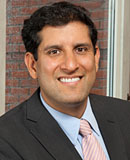 Vivek Kundra
Vivek Kundra
Shorenstein Center Fellow,
Fall 2011
Executive Vice President of Emerging Markets, Salesforce.com; Former U.S. Chief Information Officer
Excerpt:
A Shift in Power
In the information economy, data is power and we face a choice between democratizing it and holding on to it for an asymmetrical advantage. For example, before a 13-year race to crack the code of life was complete,1 a team of international scientists gathered in Bermuda to discuss the strategy for managing the Human Genome Project data. They made a set of critical decisions to make the human genome data freely available in the public domain. These decisions came to be known as the “Bermuda Principles.”2 This decision gave rise to an ecosystem of scientists and companies that have advanced everything from personalized medicine to creating economic activity that improves the human condition.
In today’s age of information, data is supremely important. We generate and store more data today than any other time in history. In fact, data is predicted to continue along its exponential growth curve to 1.8 zettabytes in 2011. To get a sense of this exponential growth, a zettabyte is a trillion gigabytes; that’s 1,000,000,000,000,000,000,000.3 If this data isn’t sliced, diced and cubed to separate signal from noise, it can be useless. But, when made available to the public and combined with the network effect—defined by Reed’s Law,4 which asserts that the utility of large networks, particularly social networks, can scale exponentially with the size of the network—society has the potential to drive massive social, political and economic change.
In today’s world, open data leveraged by networks is the fuel that powers important decisions at each level of society—from government, to business, to community, to households—but it is also a product of our every activity at every level of our existence. Channeling the power of this open data and the network effect can help:
- Fight government corruption, improve accountability and enhance government services
- Change the default setting of government to open, transparent and participatory
- Create new models of journalism to separate signal from noise to provide meaningful insights
- Launch multi-billion dollar businesses based on public sector data
Technology enables the disruption of institutions that was structurally not even possible before. The adoption of social, mobile and cloud technologies is lowering the co-efficient of friction and giving rise to the network effect that has already changed the power dynamics between large institutions and the people.
Facebook has more than 800 million active users5 and Twitter has over 100 million active users.6 These are still early days in the social space when you consider that there are approximately 7 billion people7 in the world and 5 billion people8 with mobile devices that enable them to connect in ways that were impossible just years ago. The ability of 5 billion people to instrument the world and share their experiences in a low-cost manner has forever shifted power away from the hands of the few to the network.
1. U.S. Department of Energy, “The Human Genome Project,” http://www.ornl.gov/sci/techresources/Human_Genome/project/about.shtml.
2. Michael Nielson, Reinventing Discovery: The New Era of Networked Science (Princeton University Press, 2011), 7.
3. Juan Enriquez, “The Glory of Big Data.” Popular Science, October 31, 2011, http://www.popsci.com/technology/article/2011-10/glory-big-data.
4. David P. Reed, “The Law of the Pack,” Harvard Business Review, (2001): 1.
5. Facebook, “Facebook Statistics,” http://www.facebook.com/press/info.php?statistics.
6. Twitter, “One hundred million voices,” http://blog.twitter.com/2011/09/one-hundred-million-voices.html.
7. Census Bureau, “U.S. & World Population Clocks,” http://www.census.gov/main/www/popclock.html.
8. BBC News, “Over 5 billion mobile phone connections worldwide,” http://www.bbc.co.uk/news/10569081.

